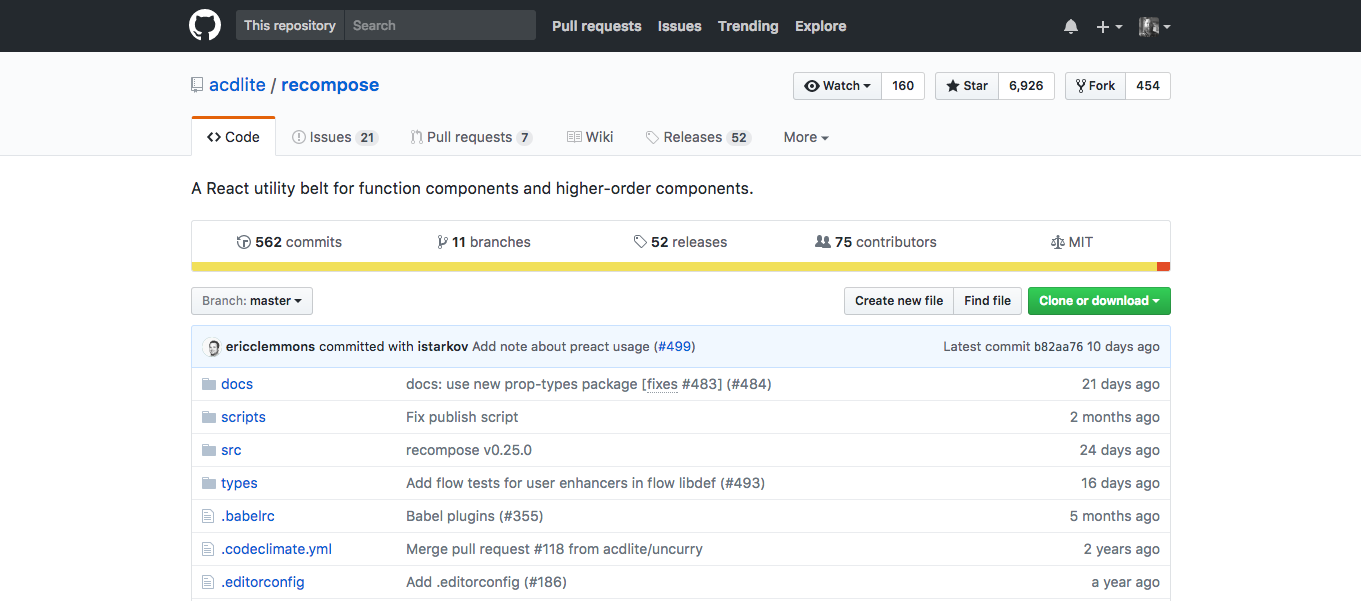Learn You Recompose
With a Side of Functional Programming
Who Am I?
Kyle Shevlin
- Senior Software Engineer at Fastly
- Lover of JavaScript
- Hater of Semicolons (in my JavaScript)
- Twitter - @kyleshevlin

What will we cover?
Recompose

Basic FP
- Functions as First-Class Citizens
- Higher Order Functions
- Currying & Partial Application
- Composition
How to write our own HOCs
How to use Recompose
(of course!)
And some demos
Basic Functional Programming
...or The Minimum Amount of Functional Programming You Need to Know to be a Danger to Yourself and Coworkers :)
Functions as First Class Citizens
function add (x, y) {
return x + y
}
const sum = add(add(4, 3), 2)
console.log(sum) // 9
"Functions as first class citizens" means you can pass function anywhere as if it's a variable.
Higher Order Functions
A "higher order function" does one of the following:
- Takes a function as an argument
- Returns a function
function emojiLogs (emoji) {
return function (...strs) {
console.log(`${emoji} ${[...strs].join(' ')}`)
}
}
const catLog = emojiLog(😻)
const dogLog = emojiLog(🐶)
const logLog = emojiLog(🌲)
catLog('Krios', 'Tali')
// 😻 Krios Tali
dogLog('<- Why do I not have one of these yet?!')
// 🐶 <- Why do I not have one of these yet?!
logLog('Douglas Firs are real nice!')
// 🌲 Douglas Firs are real nice!Currying & Partial Application
Currying is the technique of refactoring a function that normally accepts multiple arguments into one that accepts them one at a time.
A curried function will continue to return a unary function for each argument until the final one is provided. Then, the function is evaluated.
The arguments provided to a curried function are said to be "partially applied" while the function awaits its final argument.
The Canonical Example
// add : Number -> Number -> Number
const add = x => y => x + y
const add2 = add(2) // The number 2 is partially applied
const add5 = add(5) // The number 5 is partially applied
const eight = add5(3) // 8
console.log(add2(eight) // 10Composition
If you remember high school math, composition is the act of passing the result of one function to another function.
This takes the form of `f(g(x))` where `f` and `g` are both functions. But nesting functions in JavaScript can be really ugly.
const scream = str => str.toUpperCase()
const exclaim = str => `${str}!`
const repeat = str => `${str} ${str}`
const warnSteve = repeat(exclaim(scream('Steve, the world is coming to an end')))
console.log(warnSteve)
// STEVE, THE WORLD IS COMING TO AN END! STEVE, THE WORLD IS COMING TO AN END!Instead of nesting functions, what if we used currying and partial application to create a function that would do the composition for us?
// Pretend we imported `scream`, `exclaim`, and `repeat` from the previous slide
const compose = (...fns) => value =>
fns.reduceRight((accumulated, fn) => fn(accumulated), value)
const withGusto = compose(
repeat,
exclaim,
scream
)
const warnSteve = withGusto('Steve, the world is coming to an end')
console.log(warnSteve)
// STEVE, THE WORLD IS COMING TO AN END! STEVE, THE WORLD IS COMING TO AN END!Higher Order Components
What is a HOC?
A higher order component is a function that takes a Component as one of its arguments and returns a new Component.
// identityHoc : Component A -> Object -> Component B
const identityHoc = BaseComponent => props => <BaseComponent {...props} />
// User : Object -> Component
const User = ({ name, age }) =>
<div className='user'>
<h3 className='user-name'>{name}</h3>
<div>Age: {age}</div>
</div>
const AlsoUser = identityHoc(User)
React.render((
<div>
// Both these will render identically
<User name='Kyle' age='32' />
<AlsoUser name='Kyle' age='32' />
</div>
), document.getElementById('app'))A Basic HOC
Why Use HOCs?
- DRYs up code
- Separates logic and view concerns
- Are composable
Recompose API
Finally!
You're working with stateless functional components, what might be the first thing you need to make them more useful?
withState
The withState higher order component allows you to add state to SFCs which get passed as props to the component.
// withState(
// stateName: string,
// stateUpdaterName: string,
// initialState: any | (props: Object) => any
// ): HigherOrderComponent
const withToggle = withState('isToggled', 'setToggle', false)withHandlers
The withHandlers higher order component allows you to add handler functions for updating state in SFCs. Also passed as to SFCs which get passed as props to the component.
// withHandlers(
// handlerCreators: {
// [handlerName: string]: (props: Object) => Function
// }
// ): HigherOrderComponent
const withToggleHandlers = withHandlers({
show: ({ toggle }) => () => toggle(true),
hide: ({ toggle }) => () => toggle(false),
toggle: ({ toggle }) => () => toggle(x => !x)
})withReducer
The withReducer
higher order component allows you to use a Redux-like reducer to handle state.
// withReducer<S, A>(
// stateName: string,
// dispatchName: string,
// reducer: (state: S, action: A) => S,
// initialState: S | (ownerProps: Object) => S
// ): HigherOrderComponent
const withToggleReducer = withReducer(
'isToggled',
'dispatch',
(state, action) => {
switch (action.type) {
case 'SHOW':
return true
case 'HIDE':
return false
case 'TOGGLE'
return !state
default:
return state
}
},
false
)lifecycle
The lifecycle higher order component allows you to add all the lifecycle methods (except for render) to a SFC.
// lifecycle(
// spec: Object,
// ): HigherOrderComponent
const withData = lifecycle({
componentDidMount () {
fetch('data.json')
.then(response => response.json())
.then(data => this.setState({ data })
}
})pure
The pure higher order component returns a `PureComponent` version of your SFC.
💥
Next slide.
mapProps
The mapProps higher order component allows you to massage the ownerProps for the base component.
// mapProps(
// propsMapper: (ownerProps: Object) => Object,
// ): HigherOrderComponent
const alwaysSteve = mapProps({ name: 'steve' })
withProps
The withProps higher order component allows you to merge new props with the ownerProps of the base component.
// withProps(
// createProps: (ownerProps: Object) => Object | Object
// ): HigherOrderComponent
const mergeSteveAndKeepTheRest = withProps({ name: 'Steve' })renderComponent
The renderComponent higher order component allows you to... well, render a component. It's useful in conjunction with the next HOC.
// renderComponent(
// Component: ReactClass | ReactFunctionalComponent | string
// ): HigherOrderComponent
const User = ({ name }) => <span>{name}</span>
const hocUser = renderComponent(User)branch
The branch higher order component allows you to conditionally choose between higher order components. Really powerful when used with renderComponent or renderNothing
// branch(
// test: (props: Object) => boolean,
// left: HigherOrderComponent,
// right: ?HigherOrderComponent
// ): HigherOrderComponent
const Left = () => <span>Left</span>
const Right = () => <span>Right</span>
const predicate = ({ isLoading }) => isLoading
const withLoading = branch(
predicate,
renderComponent(Left),
renderComponent(Right) // This can be implicitly supplied by the base component
)
We'll do it live!

withSpinnerWhileLoading
We'll make a higher order component that will show a spinner until our data has loaded that we can use on any similar component.
Resources
- Tim Kindberg's Recompose series on Egghead.io
- Andrew Clark -- @acdlite
- A. Sharif -- @sharifsbeat
- The Mostly Adequate Guide to Functional Programming by Professor Frisby aka Brian Lonsdorf aka @drboolean